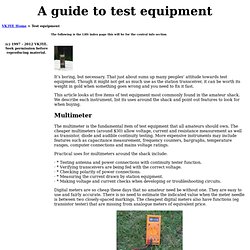

Testing -> Bench. VE7CA's Test Bench Since becoming an amateur radio operator I have built a lot of equipment.

Testing is the most important part of building a working high performance homebrew amateur radio transciever. One never seems to have enough test equipment so always keep your eyes open when attending swap meets etc. for test equipment that you don't have in your shack. The workshop where I build and test my equipment is located in a closet that is located adjacent to my ham radio operating desk. 8 foot wide folding doors provide a way of hiding the sometimes messy work shop. The following picture shows the current setup with room for parts bins and test equipment. The following photos show some of the test equipment I built during the development of the HBR2000.
Various other pieces of homemade test equipment (not scope). More small pieces homemade test equipment. I built this generator to enable development and testing of the noise blanker in the HBR-2000. Photo of the RF Pulse Generator. Test Equipment / Technical Reference: Test Equipment. Vk3ye dot com - Simple test equipment to build. This month we plug in our soldering irons and put together some pieces of basic test equipment.

Though inexpensive, the projects described will prove useful in the radio shack. Any one of them can be assembled in an afternoon. They are described in order of complexity, so that the reader can find a project suitable for their expertise. Field Strength Meter A field strength meter is perhaps the simplest piece of RF test equipment that can be built.
Figure One below shows a schematic of an RF field strength meter. The meter works by converting any RF signal present at the antenna to a DC voltage. Because it uses few parts, a printed circuit board is not necessary; components can simply be soldered to one another. A meter from an old radio or tape recorder should work fine. To test the operation of the meter, a transmitter is required to provide a source of RF. The field strength meter is a useful instrument in its own right, but it can be made more versatile. Crystal tester. Vk3ye dot com - A guide to test equipment. It’s boring, but necessary.

That just about sums up many peoples’ attitude towards test equipment. Though it might not get as much use as the station transceiver, it can be worth its weight in gold when something goes wrong and you need to fix it fast. This article looks at five items of test equipment most commonly found in the amateur shack. We describe each instrument, list its uses around the shack and point out features to look for when buying. Hamradio_testequipment01. The intricacies of installing, optimizing and keeping your radios working is as much art as it is science.

A combination of electrical theory, physics, math, and magic must come together perfectly or your signal does not get out. Or even worse it gets out but poorly. It takes a specialized group of tools and diagnostic equipment to install your radios properly and to tweak all of the necessary adjustments. Tools and Test Equipment for the New Ham Radio Operator.
Tools,Test Equipment and Shack AccessoriesFor The New Ham Radio OperatorBy N4UJW This article is tailored for the new ham radio operator so if you have been a ham for many years, you already know that there are a few required tools and test equipment you need to be able to maintain your station, it's accessories and your antenna setup.

And if you are married, your wife may suddenly realize you are smarter than you look and she may think that since you are a ham radio operator, you have suddenly gained the knowledge to repair ANYTHING "electrical" around the house! This depends on your wife! If you want more operating time on the air, my advice is to reply to a "Can you fix this? " from her....is to just say a polite.... " And as an added thought, depending on how you handle it, a "fix it" opportunity for her may be to your advantage if every time you needed a new tool or piece of test equipment for ham radio, you could justify the expense of it with her now that you are a ham! 1.